Denton
Denton Town Centre
Services in Denton
Tameside Image Archive
Tameside Image Archive
Take a look at the historical images of Tameside we have available.
Denton Roll of Honour 1914-1918
Denton Roll of Honour 1914-1918
View our roll of honour for those who served in the First World War.
Sustainability in Green Flag Parks
Sustainability in Green Flag Parks
Have a look at sustainability at our local parks.
Coat of Arms
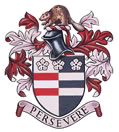 Per pale argent and sable, two bars per pale gules and of the first, in chief three pierced cinquefoils ermine. Crest: On a wreath argent and gules, a beaver proper charged with two mullets in pale Or. Motto: Persevere. Granted 23 March 1936.
Per pale argent and sable, two bars per pale gules and of the first, in chief three pierced cinquefoils ermine. Crest: On a wreath argent and gules, a beaver proper charged with two mullets in pale Or. Motto: Persevere. Granted 23 March 1936.The coat of arms shows a beaver which is a symbol of the hatting industry. The arms are based on a previously unofficial device representing the union of the townships of Denton and Haughton.
History of Denton
Early History
There are at least two explanations for the name Denton - that it meant 'Dane Town' or 'valley settlement', 'den' meaning valley 'ton' meaning settlement. Denton is mentioned in several 14th century documents, referred to as Denton-subter-Danerhaugh, and by the 1660s it was a large village of 500 inhabitants. The population in 1801 was 2,500, in 1841 was 7,000, and by 1950 over 25,000. The large increase during the 19th century was due to Denton becoming a suburb of Manchester.One of the most remarkable buildings existing in Denton today is St. Lawrence's known as Denton Old Church, or 'Old Peg', because of the wooden pegs used in its construction. It was built in 1530 and, despite alterations and renovations, is still not greatly changed today.
In 1884 the local governments of the townships of Denton and Haughton were amalgamated under one authority - the Denton and Haughton Local Board - and in 1894 the Committee of the Lancashire County Council decided that Denton and Haughton were to be united and known as the Denton Urban District Council. The free library was planned to celebrate Victoria's Jubilee in 1887 and was opened on April 28, 1888. The cemetery opened in 1894, also allowing the public access to woodland surrounding it, and in 1913 Denton Park opened.
Communications
In 1765, after an Act of Parliament, the main road from Stockport through Denton to Ashton was widened and improved and the first Toll Bar established at Denton. The main highway connecting Denton with the 'outer world', the Manchester to Hyde road, was opened after an 1818 Act of Parliament. The railways arrived in October 1882, although in 1853 there was a private railway between Denton Collieries and the Stockport-Ashton line.Industrialisation
Coal mining has been in existence in Denton for over 2,000 years. There is a record in the registers at Denton Old Church of a man killed in a pit at Haughton in 1743. At one time coal mining was one of the most important industries in Denton. The main mine was Denton Colliery Co. and the shaft known as Burton Nook was sunk in 1841. Other pits were Hulme's Pit and Top Pit. In April 1926, during the Great Coal Strike (usually known as the Miner's Strike), the mines were closed for several weeks.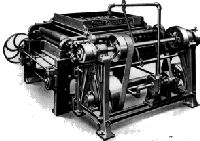 Hatting was a major industry in Denton, originating in the 16th century when local farmers made coarse felts from wool and rabbit fur in small workshops attached to the farms. In the 1700s some hatters began employing workers and, by 1825, there were 20 firms in existence. The industry expanded in the 1830s but in the 1840s and 1850s depression, a strike in 1841 and a fall in demand for felt hats created a slump in hatting. Wages fell by 35 per cent, unemployment rose and many families had to leave the district for work. The industry improved after 1860 - mechanisation increased production as demand returned and many felt hatters moved into the previously despised silk hat trade. The decline, which started in 1920s, as bare heads became acceptable and hats began to be used for 'special' occasions, never halted, and hatting today no longer has the importance it had in Denton in the 19th and early 20th centuries.
Hatting was a major industry in Denton, originating in the 16th century when local farmers made coarse felts from wool and rabbit fur in small workshops attached to the farms. In the 1700s some hatters began employing workers and, by 1825, there were 20 firms in existence. The industry expanded in the 1830s but in the 1840s and 1850s depression, a strike in 1841 and a fall in demand for felt hats created a slump in hatting. Wages fell by 35 per cent, unemployment rose and many families had to leave the district for work. The industry improved after 1860 - mechanisation increased production as demand returned and many felt hatters moved into the previously despised silk hat trade. The decline, which started in 1920s, as bare heads became acceptable and hats began to be used for 'special' occasions, never halted, and hatting today no longer has the importance it had in Denton in the 19th and early 20th centuries.There were many industries in Denton linked with the hatting trade. Turner Atherton and Co Ltd, founded in 1860, were inventors and makers of machinery for all hatting purposes. The Denton Fur Cutting Company, H & P Richardson, engineers millwrights and hatters machinists, Clayton and Web, hat leather stitching and producers of other hatting specialties are just a few examples of industries connected with hatting.
The Woolfenden Family
Thomas Woolfenden who was a member of the first Urban District Council was a member of the famous hatting family of J Woolfenden & Co, founded in 1830. With the other major hatting families in the area, such as Walker, Ashworth and Linney, James Bevan and Co Ltd, J Howe and sons Ltd, J Moores and Sons Ltd, they played an important role in the social, political and industrial life of the town.The Board of Guardians, the UDC, local parliamentary parties and local churches all counted members of the Woolfenden and other hatting families on their committees. The members of the wealthy hatting families also contributed to various funds such as the Denton Prize Band and Denton Cricket Club.
Joseph Woolfenden came to Dane Shot Bank Farm as a farmer from Bury around 1820 and, by 1830, was manufacturing hats in a small workshop adjacent to the farm. Hatting at Dane Bank, and elsewhere in Denton, was still a supplement to agriculture. This small-scale industry soon outgrew the workshop and a large factory was built nearby. Houses were constructed for the workers at Joseph Street and Daneshot Street and, by 1873, the factory had to be extended to accommodate extra machinery as all the hatting processes were completed under one roof. The Woolfenden brothers had three large houses built for themselves in Dane Bank, symbols of their new status of wealthy hat manufacturers, successful financially and socially.
Hatters Unions
The earliest felt makers were controlled by the Haberdashers Company, but in 1604 the Felt Makers Company was granted its own charter. In 1790 Trade Clubs were organised into the Hatters Society of Great Britain and Ireland, or the Fair Trade Union. In the 19th century the northern workers split with London and formed the Blue Black Union. Men in unions or Trade Clubs received sickness, unemployment and death benefits in return for weekly subscriptions and, when unemployed, tramping for work, they received financial help and advice about work when they presented their card at a turn-house - often a pub such as the Red Lion at Denton. After 1862 contributions were 6d per week, unemployment benefit 7/- for 13 weeks, and funeral benefit £5 for each member or wife.In 1879 the Amalgamated Society of Journeymen Felt Hatters brought together all the various societies and associations and headquarters were set up in Denton where the union held meetings at the Jolly Hatters Arms. The depression of the 1840s and the strike of 1841 were major factors behind the large numbers joining the union. Unions were also set up for women and juveniles to prevent exploitation of their cheaper labour.
The unions were constantly improving wages and conditions. In 1928 Thomas Mallalieu, general secretary from 1894-1934, was working for a report and discovered that in 1900, hours were over 55.5 per week, the average age at death of members was 45 years 9 months, and half died of chest complaints. By 1927, conditions had been improved, hours reduced to 46.5 per week, the average age at death was 64 years and a quarter died of chest complaints. Even after the decline of the importance of hatting the union still campaigned for improved conditions and wages. By 1965 they had a 40 hour week and three week's paid holiday.
The Twentieth Century
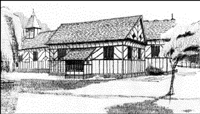 New opportunities have arisen with construction of new motorways. The M67 at Denton opened in September 1981 and the M60 is now complete. Denton roundabout (M63/M67/A57) has already seen a new Sainsburys store, a Whitbread Travel Lodge and Stablegate Restaurant, and a Toyota car showroom. The area has a number of key employment sites along the M60. The Blueprint for Denton reveals plans to revitalise the Town Centre, Crown Point and the Town Hall. In 1991 the town's population was 35,820.
New opportunities have arisen with construction of new motorways. The M67 at Denton opened in September 1981 and the M60 is now complete. Denton roundabout (M63/M67/A57) has already seen a new Sainsburys store, a Whitbread Travel Lodge and Stablegate Restaurant, and a Toyota car showroom. The area has a number of key employment sites along the M60. The Blueprint for Denton reveals plans to revitalise the Town Centre, Crown Point and the Town Hall. In 1991 the town's population was 35,820.
Facts About Denton
A comprehensive selection of historical photographs can be found at www.tameside.gov.uk/history- The town Denton resides in Tameside
- The name Denton means "a village in a valley"!
- There was once at least 4 cinemas in Denton! The Palace on Ashworth Street opened in 1912 and could seat nearly 900 people. It closed in 1959 and was demolished in the early 1970s to become the Co-op car park. The Barcliff on Ashton Road opened in 1939 as a cinema and closed in 1996 as a bingo hall. There was also the People's Hall on Prestwich Street, which was a cinema from 1908 to 1958, and until recently, was a roller skating rink and The Rota on Thornley Lane.
- Hatting was the most prominent industry in Denton, as by 1800, there were at least twenty listed manufacturers. However, over the years there were a total of 86 Hatting firms listed. Some of the more famous ones include Howes, Wilsons, J and T Moores, Walker, Ashworth and Linney, William Brown and Sons Ltd, James Bevan and Co, and Messrs Cook, Smith and Co.
- Denton Central Primary School, once known as Denton Council School, Duke Street, was converted to a military hospital during the First World War. During the Second World War it was used as a first aid station, run by the St John Ambulance Brigade.
- Private Albert Hill was awarded the Victoria Cross during the First World War. He had been a planker at Wilson's Hat Works until he joined the army. He was awarded the medal, along with the French Croix de Guerre and the Russian Cross of St George for his bravery on July 20th 1916. On this day he took part in an attack on Delville Wood and whilst separated from the main attack party he came upon the enemy position and killed nineteen Germans by throwing grenades, the rest scattered. He then carried a wounded captain back to safety and captured a further two Germans. He was the only hat worker to win the Victoria Cross.
- On 17th July 1942, a German bomb was found at Hyde Hall Farm. The bomb had lain twenty-five feet down in a field, unexploded, since the Christmas blitz of 1940. After being defused, it was then displayed on the bandstand in Victoria Park, Denton, for a month to raise money for the National Air-Raid Distress Fund.
- Francis Kirk and Son Ltd of Saxon Street, Denton has been in business in Denton since it's formation in 1868. The company has been owned and run by the Kirk Family, who are still actively involved.
- Mick Hucknall, the lead singer with Simply Red, was brought up in Denton, attended Audenshaw School, before continuing his education at Tameside College and Manchester Polytechnic's School of Art.
- On a stone plinth outside the Church of St. Lawrence in Denton this plaque remembers John Angier.
- In the grounds of the Church of St. Lawrence a plaque celebrates the history of the building, Denton Church.
- On the former Denton Town Hall on Market Street a plaque was unveiled on 18th September 1993 to commemorate the signing of the Charter of Friendship between Denton and Montigny le Bretonneux.
- The town of Denton has proud links with Albert Hill who, despite being a weak and frail child, became a great soldier awarded the Victoria Cross for his action at the Somme. The blue plaque is located in the Memorial Gardens in Denton.
- A plaque is erected on a building on Wilton Street in Denton. It commemorates all those women who worked in the Hatting industry during the time of Industrial Revolution and pays tribute to their fortitude.
- Sir Geoff Hurst was born was born at Tameside Hospital’s forerunner, the old Lake Hospital, Ashton, in 1941. He lived on Ruby Street and Cemetery Road, Denton, and attended St Lawrence’s School, Stockport Road, until the family moved to Essex when he was eight.
- Jimmy Armfield, Blackpool and England professional football player and manager, was born on Marina Avenue, Denton. His dad managed Haughton Green Co-op but took the family to Blackpool when war broke out.
Places of Interest in Denton
Denton St Lawrence Church
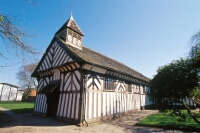 The Chapel is generally thought to have been built in 1531, but has been considerably altered since. It is a Grade II Listed building with many features of interest and a fascinating history. The story of St Lawrence's is available at the Church. Tours can be arranged.
The Chapel is generally thought to have been built in 1531, but has been considerably altered since. It is a Grade II Listed building with many features of interest and a fascinating history. The story of St Lawrence's is available at the Church. Tours can be arranged."St Lawrence's Church and the Archaeology of the Medieval Timber-framed Churches of England and Wales".
Hyde Hall
Hyde Hall, which can be found at the bottom of Town Lane, was originally built in the sixteenth century, but was considerably altered in the seventeenth century when it was partly faced in brick. It belonged to the Hyde family of Denton, who were a younger branch of the Hydes of Hyde. When the Hyde Hall estate was sold in 1762 it comprised of 191 acres which were farmed by one family.
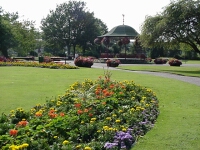
Victoria Park and Bandstand
In the summer you will find endless activities for the children around the park, or you can just sit and relax and let the various brass bands entertain you from the beautifully restored band stand!Denton Town Twinning Association
Montigny-le-Bretonneux, France since 1992
Kierspe, Germany since 2012

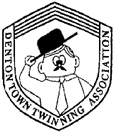
President
Margaret Downs
Chairman
Councillor George Newton
 gfnewton@hotmail.co.uk
gfnewton@hotmail.co.uk Secretary
Amanda Childs
 info@dentontwinning.co.uk
info@dentontwinning.co.uk
Montigny
The town of Montigny-le-Bretonneux is situated some 25 kilometres south-west of Paris and 5 kilometres from Versailles in the agglomération (borough) of Saint Quentin en Yveline. The town, which has been twinned with Denton since 1993 has a population of around 36,000, about the same as Denton.For more information on Montigny go to www.montigny78.fr
Kierspe
The town of Kierspe is situated in North-West Germany and is about one hour's drive from Cologne. The town is a green and hilly area and boasts many community and sports groups. Around 17,000 people live in the town and it has been twinned with Montigny for 25 years. The town became twinned with Denton on 22 September 2012.For more information on Kierspe go to www.kierspe.de
For further updates, please visit the Association's facebook page on facebook.com/DentonTownTwinning.
You can find the Association on Twitter: @DentonTwinning
Denton Town Twinning Day
Here are some photographs from our 'Denton Town Twinning Day'. The event took place on Saturday 22 September 2012 and celebrated our twentieth year twinned with Montigny and the commencement of our new twinning with Kierspe in Germany.The day was a huge success and was attended by parties from Montigny and Kierspe, including their town mayors, and The MP and Civic Mayor and residents from Denton. Alongside a free live concert, there was a farmers and crafts market on the Civic Square amongst fun and festivities for all the family. The twinning agreements were signed in Denton Town Hall followed by the planting of a German Linden Tree and a French Oak Tree in Victoria Park.
Following this, a group of Cubs from Haughton Green Scouts made their oath in English and German in the presence of the Mayor of Kierspe. The day was a huge success and highlighted the successes and benefits of twinning. The whole of the Association look forward to another prosperous and successful twenty years with Montigny and now Kierspe too.
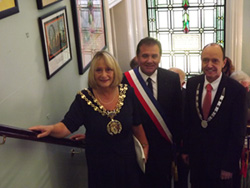
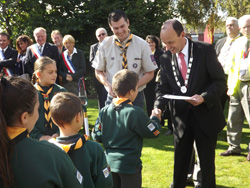
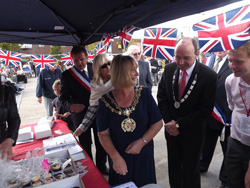
Full Steam Ahead
 Residents of Denton & Audenshaw voted to award us with a grant at the recent You Choose funding day at the Green Park Centre in Haughton Green.
Residents of Denton & Audenshaw voted to award us with a grant at the recent You Choose funding day at the Green Park Centre in Haughton Green.George Newton, organiser of the September celebrations in Denton, pitched the event to residents and councillors who voted to award Denton Town Twinning Association with a grant to fund the event.
George said “all of our members are extremely happy that we were successful. It shows that the local community are fully behind our work and plans for September”.
The celebrations will culminate on Saturday 22 September 2012 with lavish town celebrations and live music in Denton Town Centre and Victoria Park.
Appointments at the AGM
At our AGM on the 21 May the following members were appointed as principal officers of the Association. The positions of President which has been held for many years by Councillor Margaret Downs and that of Chairman, held by Alan Marrow were uncontested and both these members have agreed to continue in office.The position of secretary had become vacant owing to the untimely death of our dear friend Elaine Sancto. Mr Robert Ganley asked to be considered to take on the role and the vote in favour was unanimous. Our treasurer Diane Roache, a long standing member of the Association, had decided not to put her name forward to continue in office and, after consideration, the position went to one of our younger members Kieran Byrne. He will also combine the task of seeking funding for specific projects as well as maintaining the Association’s accounts. Members recorded a vote of thanks to Diane for her many years of service as treasurer and were delighted to hear that we will continue to benefit from her experience of Twinning and her wise councils. George Newton is to continue as our Deputy Chairman.
 For more information on Montigny go to www.montigny78.fr
For more information on Montigny go to www.montigny78.fr Also visit our Facebook page

